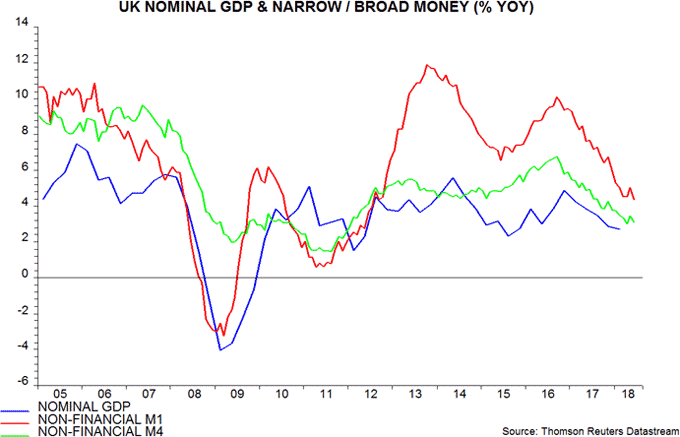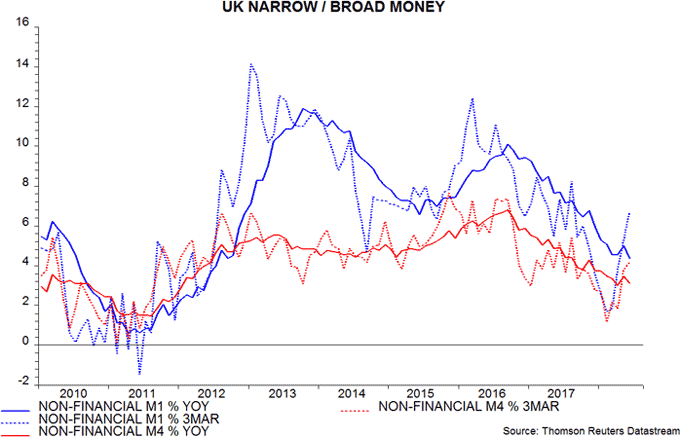
Janus Henderson: No monetary case for UK rate hike
UK monetary trends are showing signs of recovery but remain weak, arguing against the rate hike that the Monetary Policy Committee is expected to deliver this week.
06.08.2018 | 11:42 Uhr
As usual, the focus here is on “non-financial” broad (M4) and narrow (M1) monetary aggregates, comprising money holdings of households and private non-financial businesses. The Bank of England’s M4ex measure additionally includes money held by non-bank financial corporations (excluding intermediaries) but such holdings are volatile and uninformative about future spending on goods and services*.
Annual non-financial M4 growth was 3.1% in June, which compares with a recent low of 3.0% in April and a peak of 6.8% in September 2016. Annual non-financial M1 growth fell further to 4.4% in June, a six-year low and down from 10.1% in September 2016 – see first chart.

As the chart shows, the collapse in money growth since 2016 has been reflected in a significant slowdown in nominal GDP, annual expansion of which is currently estimated by the Office for National Statistics to have fallen to only 2.7% in the first quarter of 2018.
Three-month growth of the two aggregates recovered during the second quarter, suggesting a stabilisation or modest revival in the annual rates of expansion – second chart. A significant pick-up, however, would be required to warrant concern that monetary conditions are too loose for achievement of the inflation target over the medium term.

Current monetary trends, indeed, argue that an inflation undershoot is more likely. The velocity of non-financial M4 – i.e. the ratio of nominal GDP to the aggregate – has fallen at an average rate of 0.7% per annum (pa) since end-2009, compared with a reduction of 3.0% pa over the prior decade. Assuming a continued decline of 0.7% pa, current annual growth of non-financial M4 of 3.1% in June, if sustained, would result in a 2.4% pa rate of increase of nominal GDP. This would imply an inflation undershoot unless potential economic expansion is well below 1% pa.
The MPC has a long tradition of ignoring monetary trends and continues to make serial policy mistakes as a result. It failed to lean against monetary buoyancy in the mid-2000s, prolonging and magnifying the credit bubble. It was slow to launch QE after the bubble burst and monetary trends stagnated.
After an initial recovery, money growth fell back in 2010 but the Bank of England proceeded to wind down the special liquidity scheme, which had provided significant support for bank balance sheet expansion, thereby exacerbating monetary weakness and contributing to the 2011-12 economic slowdown and double-dip scare.
The most recent mistake was to cut rates and launch additional QE in August 2016 despite strong money growth, which signalled that the economy was likely to continue to expand despite the negative shock of the EU referendum result. This unnecessary policy easing magnified sterling weakness and associated upward pressure on import prices and inflation.
The MPC now appears poised to make the opposite mistake. Three-month growth of the money measures fell sharply immediately after the November 2017 rate hike – second chart. A similar response to an August 2018 increase could result in annual rates of expansion declining to dangerously low levels. Why run this risk? The MPC should skip policy action this week and make a November rate increase conditional on a further recovery in monetary trends.
*M4ex is giving a similar message to the non-financial monetary aggregates currently.




Diesen Beitrag teilen: